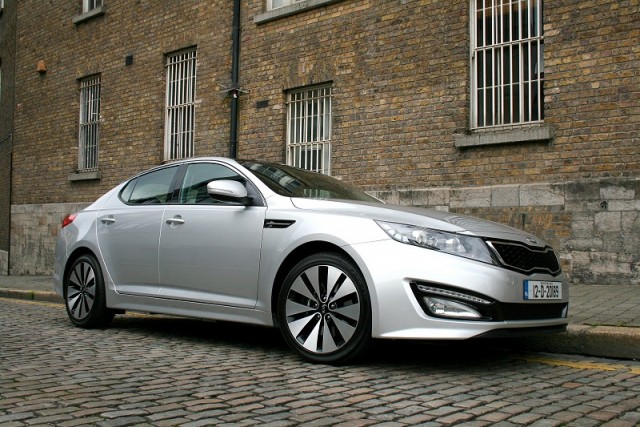If you remember the Kia Magentis then you're in the minority. It was not a good car and didn't trouble the established class leaders - regardless of its low price. The Optima is effectively its replacement, though the new car is a world apart, in virtually every aspect - starting with a stunning look that really sets it apart.
Inside & Out: 4.5/5
Is there anyone out there that doesn't agree with a full five-star rating for the exterior design of the Kia Optima? We reckon it's the best-looking car in the D-segment bar none, even when compared to premium models from the likes of Audi and BMW. It's far more interesting to look at than the top selling saloons of the same size in Ireland, especially when fitted with the (more expensive) striking 18-inch alloy wheels.
We've docked the Optima half a point here because of the interior. While it's well made, well appointed and impressively spacious, the design is a little restrained after the promise of the exterior. Neither are we fans of the half-wood steering wheel that comes as standard on the Platinum model. It's well worth paying the extra for the huge panoramic glass roof though, which adds another dimension to the cabin.
Engine & Transmission: 3/5
While our test car featured Kia's six-speed automatic gearbox it's unlikely that many buyers will opt for it, as it reduces the efficiency of the car, meaning more CO2 - enough to take the Optima from Band B with a manual gearbox to Band D. That brings with it a big price jump as well as higher annual tax. And there's nothing special about the gearbox either.
If our tax system changes again then the inclusion of a 1.7-litre diesel engine (where many rivals use 2.0-litre units) could be a canny move for Kia. It's perfectly powerful enough, with 136hp and a useful 325Nm of torque produced low down the rev range. The Optima isn't a quick car, but neither does it feel in any way slow. Somewhat surprisingly, this engine is a little noisy.
Ride & Handling: 3.5/5
Again, the specification of our high-end test car affects the result. The 18-inch wheels, while cracking to look at, will reduce ride comfort. This manifests itself in a small amount of bounciness at low speeds. Thankfully this isn't noticeable as speeds rise and in general the Optima is quite comfortable. The chassis doesn't encourage quick driving, but it's highly competent and if you tackle a series of corners enthusiastically it clings on, changes directly smartly and doesn't roll about too much.
Equipment, Economy & Value for Money: 3.5/5
The entry-level Kia Optima, the EX, would score higher than the automatic version we drove because of its lower emissions and fuel consumption and indeed it's auspiciously well equipped for the starting point in the range. As standard it features Bluetooth telephony, aux-in and USB connection ports, a leather trimmed steering wheel (with controls for the stereo, phone and cruise control), air conditioning, 16-inch alloy wheels, loads of safety technology and electrically folding heated door mirrors. Not bad for €26,995.
Yet it's still worth considering paying €2,000 more for the first rung on the Platinum ladder - with a manual gearbox. That price adds parking sensors and rear view camera, heated leather seats with electric adjustment, dual-zone climate control, the glass roof, auto wipers and lights, dual-zone climate control and 17-inch alloy wheels. And of course all Kias come with a seven-year warranty.
We averaged 7.9 litres/100km (35.7mpg) in a week of mainly urban driving.





























